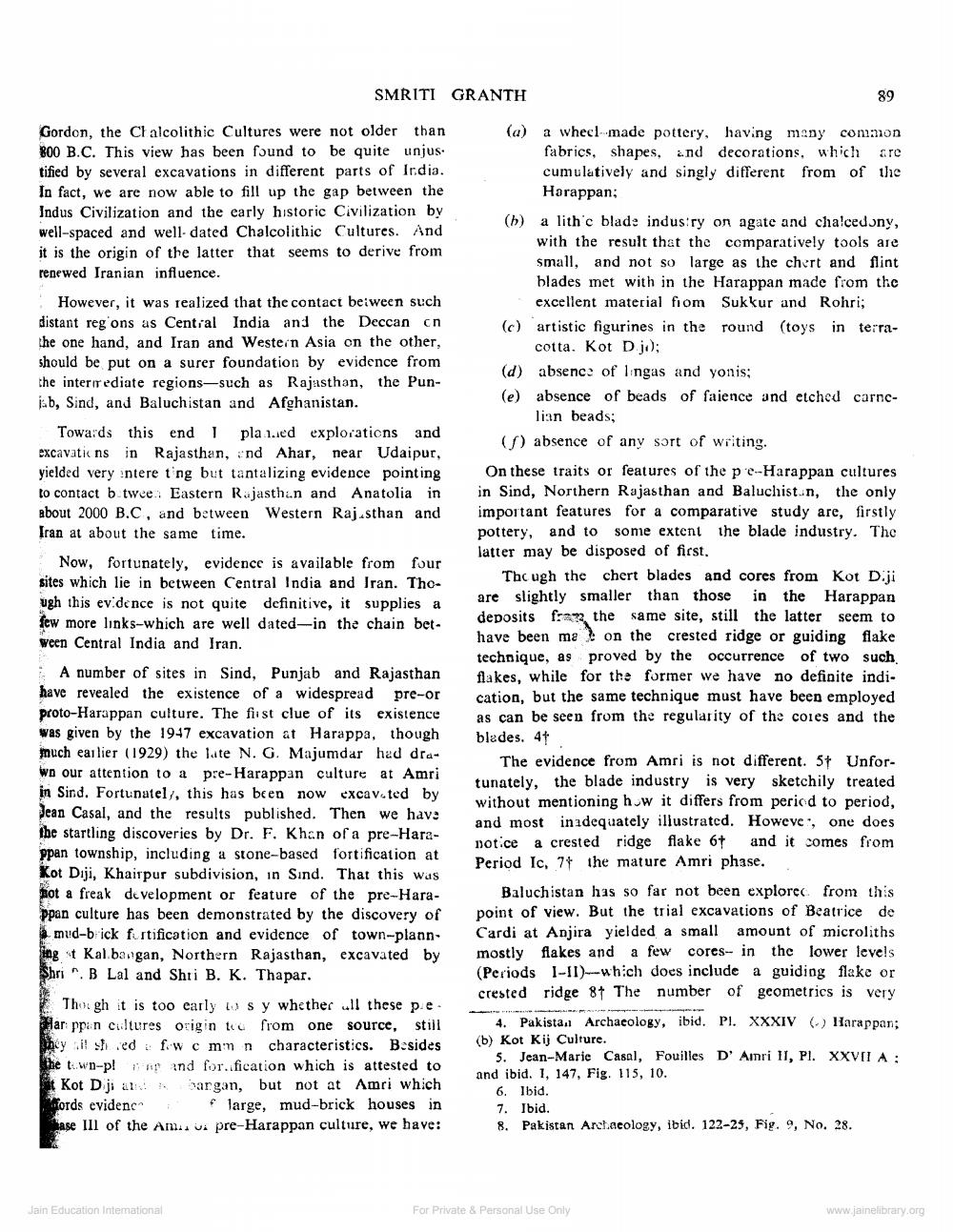________________
SMRITI GRANTH
89
Gordon, the Chalcolithic Cultures were not older than 800 B.C. This view has been found to be quite unjus. tified by several excavations in different parts of Irdia. In fact, we are now able to fill up the gap between the Indus Civilization and the early historic Civilization by well-spaced and well dated Chalcolithic Cultures. And it is the origin of the latter that seems to derive from renewed Iranian influence.
However, it was realized that the contact between such distant reg ons as Central India and the Deccan cn the one hand, and Iran and Western Asia on the other, should be put on a surer foundation by evidence from the interirediate regions—such as Rajasthan, the Punib, Sind, and Baluchistan and Afghanistan.
Towards this end I pla 1.sed explorations and excavations in Rajasthan, und Ahar, near Udaipur, yielded very intere ting but tantalizing evidence pointing to contact b twee Eastern Rajasthan and Anatolia in about 2000 B.C, and between Western Raj.sthan and Iran at about the same time.
Now, fortunately, evidence is available from four sites which lie in between Central India and Iran. Though this ev.dence is not quite definitive, it supplies a few more links-which are well dated-in the chain between Central India and Iran.
A number of sites in Sind, Punjab and Rajasthan have revealed the existence of a widespread pre-or proto-Harappan culture. The first clue of its existence was given by the 1947 excavation at Harappa, though much earlier (1929) the late N. G. Majumdar had drawn our attention to a pre-Harappan culture at Amri in Sind. Fortunately, this has been now excavated by Jean Casal, and the results published. Then we havs the startling discoveries by Dr. F. Khan of a pre-Harappan township, including a stone-based fortification at Kot Diji, Khairpur subdivision, in Sind. That this was mot a freak development or feature of the pre-Harappan culture has been demonstrated by the discovery of
mud-b ick fustification and evidence of town-plann. ingt Kalbawigan, Northern Rajasthan, excavated by Shri. B Lal and Shri B. K. Thapar.
Though it is too early tus y whether all these p.e. Har ppan cultures origin to from one source, still hey wil sted f.w c m n characteristics. Besides the town-p! An and for.ification which is attested to * Kot Dji ats a rgan, but not at Amri which Words evidence large, mud-brick houses in
hase III of the Am.. ui pre-Harappan culture, we have:
(a) a wheel made pottery, having many common
fabrics, shapes, and decorations, which are cumulatively and singly different from of the
Harappan; (h) a lith's blade industry on agate and chalcedony,
with the result that the comparatively tools are small, and not so large as the chert and flint blades met with in the Harappan made from the
excellent material from Sukkur and Rohri; (c) artistic figurines in the round (toys in terra
cotta. Kot D.jo); (d) absence of lingas and yonis; (e) absence of beads of faience and etched carnc
lian beads; (9) absence of any sort of writing. On these traits or features of the pre-Harappan cultures in Sind, Northern Rajasthan and Baluchistan, the only important features for a comparative study are, firstly pottery, and to some extent the blade industry. The latter may be disposed of first.
Though the chert blades and cores from Kot Dji are slightly smaller than those in the Harappan deposits from the same site, still the latter seem to have been me on the crested ridge or guiding flake technique, as proved by the occurrence of two such flakes, while for the former we have no definite indication, but the same technique must have been employed as can be seen from the regularity of the cores and the blades. 47
The evidence from Amri is not different. 57 Unfortunately, the blade industry is very sketchily treated without mentioning how it differs from period to period, and most inadequately illustrated. Howeve, one does notice a crested ridge flake 67 and it comes from Period Ic, 77 the mature Amri phase.
Baluchistan has so far not been explore from this point of view. But the trial excavations of Beatrice de Cardi at Anjira yielded a small amount of microliths mostly flakes and a few cores- in the lower levels (Periods I-II)- which docs include a guiding flake or crested ridge 87 The number of geometrics is very
4. Pakista, Archaeology, ibid. Pl. XXXIV (-) Harappan; (b) Kot Kij Culture.
5. Jean-Marie Casal, Fouilles D' Amri 11, Pl. XXVIIA; and ibid. 1, 147, Fig. 115, 10.
6. Ibid. 7. Ibid. 8. Pakistan Archacology, ibid. 122-25, Fig. 9, No. 28.
Jain Education Intemational
For Private & Personal Use Only
www.jainelibrary.org




